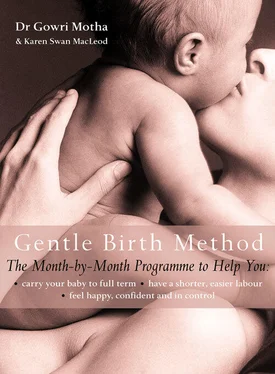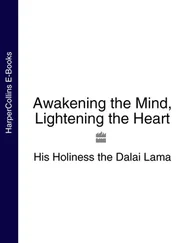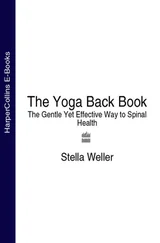So What Do Vata, Pitta and Kapha Govern?
Vata represents wind and movement. It governs motion, activity and sensory functions; it controls the activities of the nervous system, blood circulation, contraction and expansion of the lungs and heart, intestinal peristalsis and elimination, and the contractile process in muscle. Pitta represents fire and heating. It is responsible for all digestive and metabolic activities, regulating digestion and the secretions of the exocrine glands and the endocrine hormones.
Kapha represents liquid and cooling. It provides the static energy (strength) for holding body tissues together. It also provides lubricants at the various points of friction.
If any of the doshas become too dominant then the processes outlined above can cause complications.
On the following pages I have provided a basic breakdown of Ayurvedic principles, which you may find interesting and useful for more detailed diagnosis of how best to manage your pregnancy. However, whilst I am able to accurately use the Ayurvedic model in clinical practice, it takes many years to become an expert in the intricacies of Ayurveda, and it is not the aim of this book to list them here. I have kept the categories as simple as possible, but for those readers who still feel there is too much new information to absorb, stick to the general dietary guidelines at the beginning of this chapter. If, on the other hand, you are intrigued by the depth of an Ayurvedic assessment, I strongly recommend a personal consultation with an Ayurvedic practitioner, who can offer more comprehensive and accurate guidance.
Read each of the following statements and score them individually on a scale of one to five according to how accurate they are for you (0 = completely inappropriate, 5 = an accurate description). Add up the scores for each section – vata, pitta and kapha – and analyse the final scores to find your predominant dosha. Remember, the chart is a rough guide.
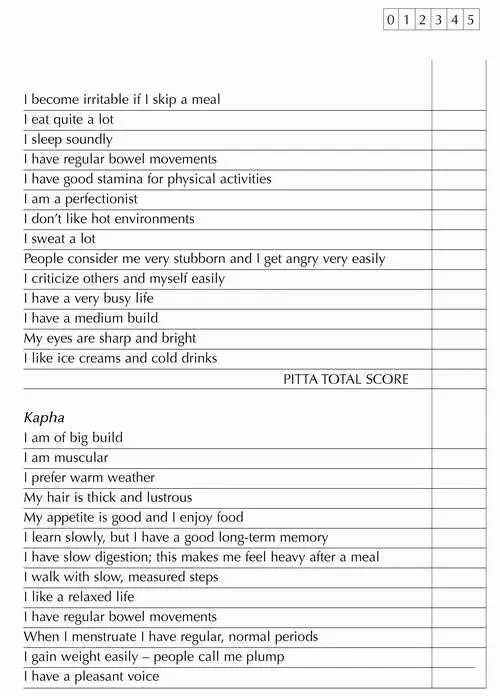
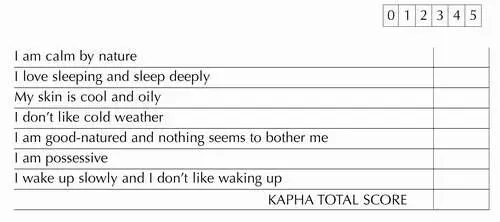
Your highest score indicates your dosha predominance. You could be a vata, pitta or kapha mother. I have described each type of mother below and provided advice on working with your predominant dosha in order to restore balance and optimum health. You may find two scores are very close – as many people are a combination of doshas rather than one distinct category – but regardless of how close the score, follow the guidelines for your dominant dosha.
Typical Characteristics
Lean, small frame
Dry skin
Mentally excitable
Weak constitution – prone to colds and illnesses
Poor circulation
Poor digestion with tendency to constipation
Low energy
May experience fainting
Vata in balance: alert and spontaneous
Vata out of balance: worried and experiences mood swings
During pregnancy
May show signs of clinical anaemia.
May feel mentally slowed down, sometimes leading to depression.
May experience aches and pains all the way through pregnancy.
May experience nausea in early pregnancy.
Note: Vata is often heightened during pregnancy, regardless of which prakruti you are.
Exercise
Exercise in moderation, as the vata mother is rather weak – engage in mild to moderate exercise only.
Walking and swimming are good.
Do indulge in some form of exercise – it has a mood-elevating effect.
Avoid going to the gym, especially in the first three months of pregnancy.
Food
Eat 3 to 4 regular light meals a day that preferably contain a representation of all the tastes like salty, sour, bitter, sweet, pungent and astringent.
Avoid snacks in between meals.
Choose clear soups.
Avoid mushrooms.
For non-vegetarians, chicken soups are recommended.
Fish is also good if you can tolerate it.
Avoid cheese as vata mothers have poor digestive power, especially in early pregnancy.
Baladi choornam (my Ayurvedic formulation) is very good for vata mothers.
Herbs
The following herbs can balance vata:
Black pepper
Dill seeds
Cumin seeds
Basil leaves
Parsley
Ginger
Music
Relaxing and calming music is very good for balancing vata.
Chanting is beneficial. Many cultures and different religious persuasions use chants (see pages 82-3 for some mantras). The Gayatri Mantra is nondenominational.
If you are religious, and depending on your religious leaning, you may like to recite prayers, such as the rosary, or Buddhist or Benedictine chants that instil peace and harmony.
Physical Treatments
Massage with oils can be amazingly effective in reducing excessive vata.
Self-massage or being massaged by your partner on a regular basis, for 20-40 minutes, is recommended. Suitable oils are virgin olive oil, or sesame oil.
Essential oils can also be used to reduce vata – try lavender, rose, or jasmine oil. Use from 4 to 10 drops in 20ml of a base oil. This can be used for self-massage or by a practitioner during general or Creative Healing massage.
Reflexology reduces vata, calms the mind and gives mental clarity. It also improves digestion and speeds up gut motility, thereby relieving constipation.
Vata Labour Issues
Factors to consider during delivery:
The pelvis is usually smaller.
The nervous disposition of vata mothers means they may experience more pain if not prepared effectively for birth.
Lots of preparation, both mental and physical, is needed to avoid surgical intervention.
Lots of low-back massage as preparation for labour will facilitate a manageable labour and gentle birth.
Vaginal oils and stretching techniques as preparation for birth are invaluable in preventing instrumental delivery.
Vata mothers need continuous massage during labour. Oil massages on the back, neck, shoulders and lower limbs are very beneficial during labour.
Vata mothers are more prone to having a retained placenta. This is not a big problem and doctors routinely administer an injection that forces the body to expel the placenta. However, many of my mothers – aiming for a natural birth – are not keen to submit to drugs at this late point in their baby’s birth, so in my self-hypnosis classes in London, I talk the mother through a hypnotic sequence in which she visualizes her body producing a surge of oxytocin (the hormone that encourages contractions) 15 minutes after the birth of the baby, thereby expelling the placenta. I have found this technique to be very effective on my vata mothers. If you are a vata mother, you can guide yourself through a short visualization of this hormonal occurrence – one or two minutes a day will be enough. You don’t need any medical expertise to do this – simply by suggesting this automatic hormonal production whilst your mind is deeply relaxed and receptive, you can pre-condition your body to expel your placenta within 10-15 minutes after the birth.
Vata mothers can have longer labours due to poor expulsive forces during labour i.e. poor uterine contractions, or uncoordinated uterine action, which can lead to slow dilation of the cervix.
Читать дальше
